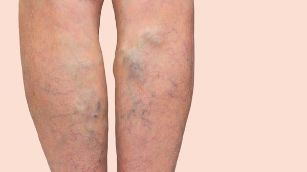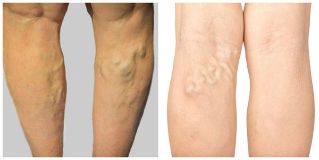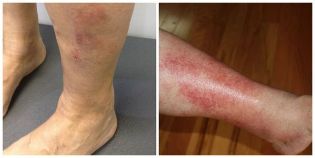Veins, varicose or varicose veins lower extremities and of primary varicose veins superficial transformation of the veins of the lower extremities, in which there are "lumps" or "knots" on his feet.

Varicose veins disease is very widespread all over the world. Its frequency reaches up to 60% of the adult population according to the country. Interestingly, the inhabitants of the African continent and the Asia-Pacific region varicose veins suffer much less than people in European countries and the USA.
In connection with the absence of definite causes of varicose veins lower extremities and the usual talk about its risk factors, and a means that increases the likelihood of developing this pathology (property or characteristic of the human body, any impact on the body). Marta risk factors, consider the age, the feminine gender, obesity and heredity. Typical "portrait" of a patient with symptoms of varicose veins — a woman in a state of menopause, excessive with body mass index, having several pregnancy and delivery in the anamnesis.
The symptoms of leg varicose veins
In the vast majority of cases, varicose veins can be recognized even special sense medical education. Clear Un goal of sign language of pathology — the appearance of "bumps" or "nodes" in the lower extremities, while the skin over them, a generally not distinguished by any special color of the. Blue veins usually are not a disease in its literal sense, although that often lead patients (most often women) of the inconvenience, of an aesthetic nature.
However, in advanced cases, varicose veins can be accompanied by skin discoloration due to eczema venous, which manifests itself in a variety itchy skin rash (blisters, nodules) and redness.
These signs, along with the legs of swelling, which does not disappear from the night which indicate formacio of the chronic venous insufficiency.
As for the subjective symptoms of varicose veins, you need to highlight their non-specificity. Complaints can indicate the disease, and can be un sign of overload of the venous system of the lower extremities. More often the patients suffer from heaviness, swelling and smooth and not the project localized pain pain in the calf. Sometimes there are complaints of pain in the area of the varicose veins and tiredness in the legs.
Burning, tingling, muscle cramps at night or restless leg syndrome (unpleasant sensations in the legs at rest when the movement to relieve this discomfort) was more on diseases commonly neurological, for example, syndrome root, and s should be considered with caution.
Pathogenesis varicose veins of the legs
Pathogenesis of varicose veins lower extremities and very complicated and versatile. The main role of the mechanism in the development of the disease play damage valves and the walls of the veins. As a result of their irregular work form un to reverse the flow of blood (reflux), then there is a loss of the endothelium (the inner lining of the vessel), and that, accompanied by inflammation.
Later in the pathological process involved the middle and inner layers of the wall vein, there is a proliferation of connective tissue in the muscle layer of the vein, original works of art and to its atrophy, which leads to a progressive destruction of the collagen of the vessel. These events elastic affect the properties of Vienna, contribute to the expansion of your light and the spiral twisting along the length. At the same time, similar changes were observed in venous valves.
It should be noted that venous visible "cops" and "knots" are the result generally of the presence of an invisible source of varicose veins great saphenous vein vein. In the vast majority of cases, and this is a big rarely small saphenous vein vein. The about the changes in the pool of these veins and lead to varicose veins.
Complications varicose veins of the legs
Complications of varicose veins has of trophic include the disorders (venous ulcers), thrombosis or varicose changed veins (thrombophlebitis) or bleeding from varicose veins or "bumps" and "nodes".
Trophic that we are the disorders of the result progression of the disease in the absence of treatment, often takes years and decades to come. They began with manifestations cutaneous hyperpigmentation (brown spots), venous eczema and lipodermatosclerosis (seal skin).
The main location of these changes in the tibia, although it can be venous eczema occur in any region of varicose veins, including the thigh. Depending on the source of varicose veins (great or small saphenous vein veins) disorders of venous will be localized either in the inner or outer surface third of the lower leg, respectively. The result of the malnutrition of the soft tissues, in la formacio d venous ulcers a term changes before. Ulcers individuals are many or with irregular shape, suspended edges and a flat, smooth (the bottom. It should be noted scant discharge, often purulent character. The sores are accompanied by pain and itching I. For venous ulcers and to highlight the existence of a time (months) and frequent recurrence.

Or Thrombophlebitis superficial venous thrombosis s should not be confused with deep venous thrombosis. In the second case, the situation and much more serious. However, in thrombotic lesions varicose veins symptoms are very unpleasant. In the region of the vein thrombosed painful threadlike forms a seal, which is characterized by redness, the local object the increase of the temperature and the object the increase of the sensitivity, sometimes the seal restricts the movement of the limb is. Clinic remember The picture more of ulcer or abscess.
Thrombophlebitis, can be very dangerous if it pren growing in nature and it moves from the superficial system to the deep. In this case, you may develop as pulmonary embolism and deep vein thrombosis.
The bleeding of the varicose veins, look very alarming, because due to the high pressure venous flow of blood strong enough. In some cases this can lead to a serious losses of blood.
Diagnosis of the legs varicose veins
Diagnosis of varicose veins lower extremities in general no problem cause no. A key feature of the disease in the presence of venous "dings" and/or "nodes". Although excessive subcutaneous fat in the development of the lower limbs to see them can be difficult.
To further confirm the diagnosis by using various methods of diagnosis instrumentals, the principal of which and ultrasound duplex scanning (USDs). That allows you to quickly, and safely, accurately determine the origin of varicose veins, in order to assess the volume and l l vessel structure of the function of venous valves, the scale of the distribution of the return of the real the blood and to detect the presence of blood clots. At the same time look deep and superficial system and venous. To carry out the research should be in the standing position or, if the patient's condition does not allow to sit with the feet. The study of the position supine can lead to errors in the determination of reflux and the formacio of blood clots.
In addition to evaluating the function of the valves and the length of a real return of blood s used:
- the compression of the test with different in the pressure of the segments limb is lower;
- the show, with the effort (Valsalva test);
- a simulation of a foot;
- welcome paraná easy to attempt the removal of the patient from the balance of the state with the aim of call to the tension of the calf muscles.
Summary of ultrasonographic duplex study of the limb, is less than veins and need to fix-in the form of an opinion, and graphics, through the development of a "vein map". The results of this study provide a valuable aid in the planning of further treatment. However, it should be borne in mind that only together with clinical data, such as changes in the ultrasound pattern in the goal of the absence of signs of disease (varicose veins) should be considered functional (and in other words, not associated with veins of pathology). It should also be noted that the ultrasound examination and is not necessarily performed if the diagnosis is clear and, I. if the patient no treatment plan of the surgical varicose veins.
There are other methods of diagnosis:
- Ultrasound Doppler — ultrasound Doppler (not to be confused with USDS);
- plethysmography;
- radiopaque venography;
- radiotelegraphy;
- computed tomography (CT);
- magnetic resonance imaging (MRI);
- thermography;
- ultrasound intravascular (IVUS), the un's new method.

Varicose vein Treatment of the legs
The main aim of treatment of varicose vein lower limbs and remove all of the improper functioning of the veins. This is only possible by means of the intervention of the non-invasive. There are three methods:
- Deleted — combined phlebectomy short vein Stripping, miniphlebectomy, perforating dissection of the veins,
- "The union" — sclerotherapy, mechanochemical ablation, cyanoacrylate obliteration;
- "Beer" — endovenous laser ablation and radio frequency.
To achieve the aim of the treatment must carry out installments: to remove the source of varicose veins (so-called vertical reflux) and remove the varicose veins. For a long time, the most commonly used was combined phlebectomy. Technique of its construction includes two stages:
- Ligation anastomosis The — the connection of the great saphenous vein vein with the Marta de la vena femoral (crossectomy);
- Remove trunk of the saphenous vein vein with the probe (Extraction).
This intervention and radical and has a number of disadvantages, inherent in any operation: frequent anesthesia need, the presence of and the incisions are sutures and important of the un's rehabilitation period and the un to increase in comparison with the other methods the risk of complications.
However, nearly twenty years ago, there was a "phlebology revolution." It was possible thanks to the wide adoption of ultrasound from l to l and l scan appearance techniques of fine — endovenous thermal ablation. We find its essence in the effects of the high temperature of the wall of the vein from the inside. For This reason, if s manages to laser radiation (EVLO) or RFR (RFO), "safariways" the light of the vein.
Immediately Vienna, let me functioning, original works of art and a little a little is resolved. Allows This method sense incision, fast, efficient, safe and aesthetically vertical nice to eliminate reflux sense the need for a great rehabilitation. Be un brilliant representative of the "office surgery", endovenous thermal ablation for ten years, and is considered to be the most optimal method of treatment of varicose veins from all over the world.
Sclerotherapy (veins ill union for the injection of a substance) also found wide use in the removal of varicose veins. However, to achieve the desired result requires a careful selection board food of patients due to the increase of the risk of recurrence of the disease.
Conservative treatments, including therapy, compression, phlebotrophic drugs and local medicinal forms (gels, ointments), are purely auxiliary in nature, that affect mainly the symptoms of varicose veins sense to remove the source code.
Forecast. Prevention
Taking into account the methods of treatment modern, the prognosis of varicose veins and favourable. Even in cases seemingly the most advanced in order to eliminate the varicose veins and make the veins leads to a rapid improvement of the condition of the patient.
However, at the time of planning the treatment and important to assess its risks, as any procedure still carries potential adverse effects. The duty of the physician and reduce its probability. Before any manipulation s should discuss the patient with all aspects of the intervention and to obtain their signature on the informed consent authority.
All adverse events can be divided into risks associated with the surgery, including the anesthesia and the risks to the patient.
The risks of surgery can be small, for example, inflammation (phlebitis) in the "prepared" or sklerozirovanie veins, followed by a stamp in their projections and moderate pain. There may be areas of the skin with a reduction of the sensitivity, and hyperpigmentation of the skin. All these side effects are temporary and usually over quite quickly sense any kind of consequences.
A complications are major deep vein thrombosis, al·al·lèrgia and reactions toxic to anesthesia. Occur very rarely, but for one patient who suffered this complication, and the case of 100%, even if the statistics of 1 case per 10,000 operations.

Prevention of venous thrombosis and mainly based on the calculation of risk called en the scale-the scale point of using the table Caprini. Contains several risk factors that have a gradation. Account of each factor and the removal of the total score determines the degree of risk and, therefore, its prevention. The main means of prevention of venous thromboembolism following:
- minimize the operation of the morbidity;
- early activation of the patient;
- the compression tights;
- prophylaxis pharmacological, and say, the allocation in accordance with the testimony of anticoagulants — drugs that thin the blood.
As for the prevention of varicose veins, simply does not exist, as it is still not clear the main cause of the pathology, which could have an impact and, therefore, of preventing their appearance. Associated with this day, and quite often the recurrence of varicose veins original works of art of any type of intervention. However, taking into account all the advantages of minimally invasive treatment, that if a un problem not significant. To keep the legs fairly simple, please refer to the main time phlebologist























